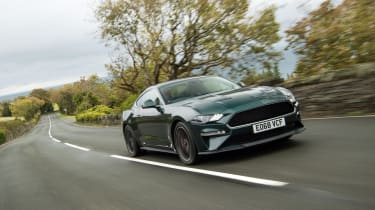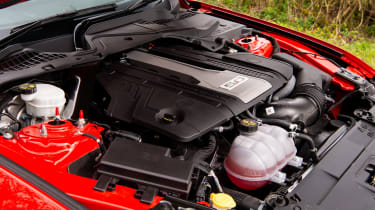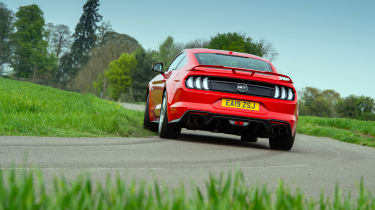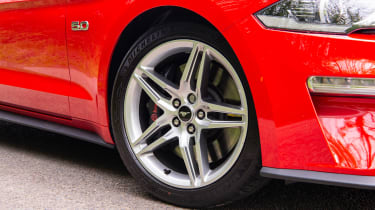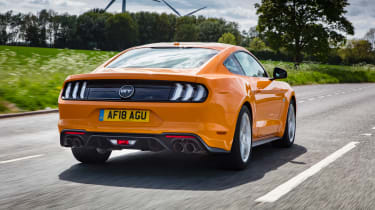Used Ford Mustang (Mk6, 2015 to date) review and buyer’s guide
It’s not going to worry a BMW M4 down a twisty road, but the Mustang’s still an entertaining sports car and makes a great used buy
The Ford Mustang is an intrinsic part of American culture and with the sixth generation it was very much back on form. For the first time there was independent rear suspension and a right-hand-drive model, and when coupled with a 5-litre V8 and a manual ’box it’s a rapid and entertaining steer.
It might not be to all tastes though as it is still a large car and can feel too big on smaller European roads, especially as the suspension can struggle to keep the Mustang’s weight in check. It’s a different take on the sports car and while not the most dynamically competent it is fun to drive and will undoubtedly put a smile on your face.
History
Launched in the UK in 2015 the sixth generation of Mustang was the first to be officially offered in the UK and come with right-hand drive. Initially it was available as the Mustang, powered by a 2.3-litre EcoBoost four-cylinder, and the GT with a far more appealing 5-litre V8. Both engines could be had in either a coupe or convertible body, and while they’re nominally four-seaters both should be very much viewed as a 2+2 at best.
There was a facelift in 2018 which saw the debut of a more powerful V8, a ten-speed automatic gearbox, some minor styling tweaks and an upgraded infotainment system. Over the years there have been several special edition models, too, including the Bullitt Mustang of 2019 that honoured the 50th anniversary of the Steve McQueen film of the same name and which benefited from revised suspension settings to give it a more involving chassis. A Mustang55 was also launched in 2019 to celebrate 55 years of Mustang production; this was mainly a styling exercise, taking inspiration from the left-hand-drive-only Shelby GT350 and GT500 models.
More reviews
In-depth reviews
Reviews
- Ford Mustang Dark Horse 2025 review – the last of a dying breed
- Ford Mustang GT 2024 review – old school in all the right ways
- Ford Mustang Mach-E GT 2023 review – it’s fast, but is it fun?
- Ford Mustang Shelby GT500 UK review – how does Ford’s maddest muscle car handle Blighty?
- Ford Mustang Mach 1 2021 review – America’s BMW M4 gets track fit
- Ford Mustang Steve McQueen Bullitt Edition 2021 review – a 720bhp tribute act
For 2021 Ford introduced the Mach 1 to the UK market, a more track-focused take on the model with enhanced aero, a Tremec six-speed manual ’box and an upgraded cooling system. As standard the Mach 1 featured a limited-slip differential and MagneRide adjustable dampers and stiffer front springs and anti-roll bars. At the same time the four-cylinder model was dropped from the UK market.
Prices, Specs and Rivals
Given the Mustang’s relatively low pricing it offers considerable bang for your buck; even the most expensive Mach 1 model cost less than £60k. When they were first launched in the UK the EcoBoost was priced from £28,995 and the GT at £33k which was very competitive and considerably less than many rivals. Prices rose over the years, taking the V8 over the £40k mark, but it doesn’t really have any rivals with V8s at that price point.
A case could be made for the Mustang being a rival for a whole host of different machinery, from BMW’s 2- and 4-series all the way up to a Porsche 911, with a diverse blend of Audi TTs, Toyota Supras, Jaguar F Types and Mercedes coupes in between. The Mustang might not be as well built, have the badge kudos or the dynamic ability of most of its rivals, but it has a brash American charm that makes it stand out from the crowd and gives it a unique appeal.
– Click here for our full review of the 2022 Ford Mustang –
Engine, gearbox and technical highlights
While its home US market gets a few more engine options than the UK you shouldn’t feel too short-changed… provided you go for the right engine. The smaller of the two units is an EcoBoost 2.3-litre turbocharged four-cylinder, and while its 286bhp might sound impressive enough, the engine itself is uninspiring and can be affected by turbo lag.
The far more enticing prospect is the 5-litre V8 that developed 410bhp when it was introduced, but this soon swelled to 444bhp in 2017. It’s a great unit with real character, the sounds suitably dramatic for an archetypal muscle car like the Mustang. The Bullitt special edition model coaxed a little bit more power from the V8 – now up to 453bhp and 390lb ft of torque – while the Mach 1 is rated at 454bhp.
Several different transmissions have been utilised – a six-speed manual, a six-speed auto and latterly a ten-speed auto. While there’s nothing particularly sophisticated about the manual – it feels robust and heavy in use and doesn’t like to be rushed – it suits the Mustang’s character well and is in keeping with the muscle car ethos. It’s also a hell of a lot better than the ten-speed auto.
The bottom line is that ten gears is just too many and from behind the wheel it feels like the box is constantly swapping cogs. This wouldn’t be so bad if the ’box was buttery smooth, but it’s not, proving to be slow and slurring in operation with the result that you’re never quite sure when each gear has slotted home. There’s a slight improvement when you use the paddleshift, but it’s by no means inspiring and lags significantly behind the ubiquitous ZF eight-speed auto that’s the industry standard these days and the numerous DSG-type ’boxes.
Performance and 0-60 time
While the EcoBoost 2.3-litre might be the sensible option, it’s still capable of accelerating the heavy Mustang to 62mph in 5.8sec for the manual and 5.5sec for the auto – impressive figures a decade or so ago, but it doesn’t really cut the mustard these days. It sounds strained and rough when extended, too, so there’s no joy in extracting the best it has to give.
Mustangs were always meant to have a V8 under the bonnet and it sounds great, as well as producing some decent acceleration figures. Since its midlife refresh the 5-litre naturally aspirated unit develops a little more power and torque and is capable of hitting 62mph from rest in 4.9sec with the manual ’box, while the auto shaves another 0.3sec from that time. Despite having a smidgen more power the Bullitt special edition is a little heavier, too, so doesn’t record any improvements on the acceleration front.
> Ford Shelby Mustang GT500 review
US special editions such as the GT350 were left-hand-drive only and never officially imported, but for the record it’ll hit 62mph in 4.3sec, while the even more bonkers Shelby GT500 with its 760bhp supercharged V8 will complete the 0-62mph dash in around 3.3sec.
Ride and handling
There’s always been a perception that the Mustang and other muscle cars of their ilk are great at going in a straight line but not very accomplished when it comes to the corners, but the Mk6 Mustang attempts to do away with that view. In part that’s down to its more sophisticated independent rear suspension – a first for a Mustang. But while it’s much better than it was, it’s still a different driving experience to most contemporary European machines.
Part of that’s down to its bulk – it’s a big, heavy (1800-plus kg) car – and always feels it when trying to thread it down a typical British B-road. However, that’s not to say that the Mustang is out of its depth as it rides pretty well given its 19-inch alloys and it exhibits a decent balance. The steering feels natural but doesn’t provide a huge amount of feedback. However, the main issue is a lack of control in the car’s body movements as if the suspension can’t quite keep up with what the road surface is tasking it to do.
Later cars have the option of MagneRide adaptive suspension that gives a decent blend of sporting and comfort depending on the road surface, and it’s a standard fitment on the Mach 1 model.
MPG and running costs
Let’s face it, you’re not going to enter into Mustang ownership and expect Fiesta running costs, and while the EcoBoost posts an official figure of 31mpg you’re not likely to see that in everyday driving. The V8, on the other hand, is considerably thirstier, recording a combined figure of 23.7mpg and you can bet your bottom dollar that will plummet drastically if the considerable performance is used. Spec the ten-speed auto though and motorway cruising won’t be too awful as top gear is very tall, with the Mustang almost sitting at tickover at the legal limit.
Watch out for VED costs, as while some Mustangs may have had a purchase price under £40k a few options will have tipped the price over that, thus attracting the additional VED rate for years two to six. Insurance will be steep, too (even the four-cylinder is in Group 41), with the V8 in Group 43. Mustangs have a yearly service schedule so will be more costly to look after than some other rivals with more modern conditioned-based servicing set-ups. Tyres won’t be cheap as they’re 19-inch items and how quickly you go through them will depend on how heavy your right foot is.
Interior and tech
There’s just about enough of the traditional Mustang architecture about the dashboard to give the interior a link to pony cars of old, yet at the same time the interior technology is just about at the level where you won’t feel like you’re missing out compared to some of the Mustang’s German rivals. Earlier cars have to make do with Ford’s Sync 2 infotainment, but this was fairly quickly changed to the far improved Sync 3 set-up which offers significant improvements including Apple CarPlay and Android Auto.
Given the performance on offer the Mustang does offer value for money, but you can see where the expense had been spared in the interior, with some scratchy plastics and the use of fairly non tactile materials here and there. Build quality isn’t on a par with that of Audi and BMW, either, but overall the Mustang’s interior isn’t dreadful by any means, just not quite hitting the standard you’ll have been used to if coming from a higher-end European marque. Meanwhile the seats aren’t the most comfortable, short of lumbar support on longer trips and not having the best lateral support, either.
Design
This generation of Mustang is a good-looking piece of kit, with enough styling cues to link it back to the iconic original without it looking like a pastiche, while the reactions from other road users and pedestrians seems to be pretty positive. The Bullitt special edition in its dark green hue with black and chrome highlights looks suitably mean and moody and draws out the best view of the Mustang’s lines.
Buyer’s guide
Prices
The Mustang has been on the market for quite a few years now and while prices have dropped they’re perhaps not yet at the level where you’d consider it a bargain. It’s still a desirable car and with no significant changes during its life the earlier cars still look pretty fresh and modern. When purchased new depreciation isn’t bad, with a three-year-old model expected to retain around 55 per cent of its original purchase price, which is good for this type of car.
The good news for the used buyer is that there are plenty of examples to choose from. Further good news come when you learn that the majority of buyers went for the V8 model so there are plenty of 5-litre machines out there, and if you’ve been seduced by the Mustang’s charms you really do owe it to yourself to bag a V8 as the EcoBoost might be good in theory but the reality doesn’t live up to the promise.
Range, specifications and options
The choice of Mustangs is effectively coupe or convertible, four-cylinder or V8 and manual or automatic, with a few special-edition models thrown in for good measure. If you broaden your search to left-hand-drive models then there are higher-performance versions such as the Shelby GT350, the track-orientated GT350 R and the Shelby GT500.
The good news is that the most plentiful model is the V8-engined coupe and this would be our choice, especially when hooked up to the six-speed manual. The soft-top is fine for roof-down summer jaunts, but it’s not as dynamically enjoyable as the hard-top. We find it hard to recommend the EcoBoost – the engine just doesn’t suit the car.
Most Mustangs come with a decent level of equipment, with the V8s having more performance-orientated kit such as a limited-slip differential and Brembo brakes. Standard equipment includes 19-inch alloys, LED rear lights, leather interior, Sync 3 infotainment and adaptive cruise control. There are plenty of the expected options to choose from such as heated and cooled seats, but perhaps the most convincing are the MagneRide dampers that improve the ride and handling.
Problems and checks
Ford doesn’t generally do all that well in reliability surveys… but it doesn’t do too badly, either, generally occupying the ‘could do better’ middle ground. It would seem that the Mustang fits into this category as while it doesn’t have a spotless reliability record it’s by no means terrible. There are a few known issues such as failing air con compressors and leaks from the oil cooler, while clonking from the front suspension is most likely to be worn anti-roll bar drop links.
The slightly budget feel to the interior can lead to wear on various interior trims and the leather perhaps isn’t quite up to the quality you’d find in other marques. Externally check for consistent panel gaps and paint matches between panels that might suggest crash damage – Mustangs are often driven enthusiastically. Check the wheels for damage and that the tyres are of a decent brand and are wearing consistently across the axles.
Recalls
There’s been just the one recall for the UK-spec Mustang and this relates to a battery wiring harness under the bonnet that may not have been correctly installed, and is only applicable to cars manufactured in 2017 and 2018, with just 399 vehicles being affected. A Ford dealer will be able to tell if remedial work has been carried out by supplying it with the chassis number.

